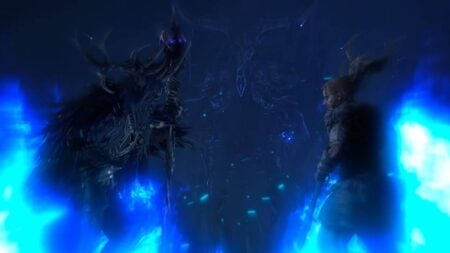Title: Trine 4: The Nightmare Prince
Developer: Frozenbyte
Publisher: Modus Games
Genre: Puzzle, Platformer
Available On: PS4,
Version Tested: PS4
Official Site: Trine 4: The Nightmare Prince
Release Date: October 8th, 2019
Where To Buy: Steam, PlayStation Store, Microsoft Store, Nintendo eShop
There’s something comforting about fantasy. The ability to escape into another world, fully immerse yourself in its wonders and forget real-life responsibilities. Playing Trine 4: The Nightmare Prince gives that warm feeling of being read a bedtime story, snuggled up by the warm fire. It’s escapist fantasy at its sweetest, which is a wonderful stark contrast from the dark fantasy worlds that plague the market.
The Trine series has gained somewhat of a cult following over the years. Originally released back in 2009, the puzzle/platformer hybrid has gone on to sell millions worldwide and make a name for itself. Trine 3 saw a shift in the mechanics and not for the better. Leaning away from the 2D gameplay style to 3D environments to explore, Trine 3 lost the charm that was bathed into the previous entries. Trine 4 thankfully proves to be a return to form, providing the series famous gameplay. With playful puzzle design and beautiful environments, this is a stellar starting point for newcomers. Featuring some of the most charming gameplay of 2019, Trine 4 is an instant surprise but is unfortunately held back from reaching greatness by uneven pacing and a lackluster story.
Lord of the Fluff
Trine 4 begins with an introductory section that showcases each of the protagonist’s abilities and personalities. Amadeus, the wizard, who provides to be the main source of the games puzzle sections. Pontius, the knight, engages in the more action-orientated portions of the game. Then there’s Zoya, the thief, who plays as the most agile of the group by being most viable within the platforming segments.
After all receiving letters about a prince who’s nightmares are becoming reality, the trio set off to assist the young prince and rid the black magic that plagues him. The plot never develops beyond this and the characters rarely get time to breathe and converse to each other. With such a thin plot that spans multiple biomes, it becomes so brisk in telling its tale that it fails to string together a coherent narrative to take these characters from location to location. What it does deliver by the barrel though, is the charm.
Every frame of Trine 4 oozes with lush fantasy environments. While the plot may meander, it does provide a means to an end by pushing our characters to these gorgeous vistas. From enchanted forests to spooky castles, Trine 4 ticks the generic fantasy checklist.
But that’s fine.
Many games of this genre aim to try something different or embrace a darker side of its stigma. So it’s refreshing that Trine 4 embraces the fantasy roots and turns the dial up to eleven. There’s a fluffiness to the whole affair that makes it so inviting that the plot plays takes a backseat to the gorgeous world created.
Good Things Come In Threes
Having three playable characters could easily be overwhelming. Each boasts its own unique play style and abilities that you could argue it’s heavy-handed. Fortunately, Trine 4 paces itself by delivering new powers consistently over the course of its 12-15 hour campaign. With such a lengthy affair, it runs the risk of becoming stagnant, but Trine 4 eases you in gently. Maybe a bit too gently, as the difficulty takes a back seat to the constantly evolving gameplay. As you come to terms with each new ability and feel ready to tackle the puzzles ahead, it often feels as though Trine 4 comes to a halt to teach you a new power. Having to repeat this process results in losing the momentum you previously had as you learn the new mechanic.
The three characters are balanced intuitively throughout, albeit with some stumbles. No single character is able to power through which means each must be utilized for their advantages. Each is used in a variety of combinations to solve the conundrums that block your path.
Amadeus assists you through the physics based puzzles that the Trine series is known for. Starting off by being able to summon a box, his powers rapidly grow to a point where multiple objects are needed to successfully pass challenges. The physics-based puzzles are where the game really shines by providing experimental play with multiple outcomes of success. Much of Trine 4 can be a cakewalk, but later physics puzzles can really push you to your limits and become satisfying gauntlets to emerge from.
Much of the platforming comes in the form of Zoya, who is definitely the most agile of the three. Sporting a bow and some rope, she is able to navigate to hard to reach places that the others are unable. Much like Amadeus, her abilities quickly grow and her powers become utilized in exciting platforming sequences. The bow she possesses is also equipped with elemental arrows, which can provide assistance such as being able to freeze a platform or burn an enemy. Her versatile move set definitely makes her the strongest of all three characters and the most well-rounded.
Claiming the short straw is Pontius, who is definitely the weakest of the trio. Starting with a very limited skill set, Pontius manages to stay on the back burner, only emerging for combat encounters. The combat is Trine 4 at its weakest. Encounters remain in a locked-off section and never develop beyond a constant button mash. Often providing an overwhelming amount of enemies, combat becomes a battle of attrition as Pontius is knocked out and you’re forced to wait for him to respawn to begin hacking away again. You can engage in conflicts with the other two characters, but enemies become so fast that your slow move set is a hindrance. Pontius gradually becomes more useful as Trine 4 progresses by possessing a shield that is used to bounce light beams and deflect projectiles. Puzzles become more reliant on his skills later on, but the first few hours use him so sparingly, it’s easy to forget his presence.
What makes each puzzle so great, is how they use consistently different mixtures of character skills. Skills can also be enhanced by spending experience orbs making for more experimental options. After Act 1 the game definitely gains more confidence and implores players to use a multitude of abilities. Occasionally a puzzle would provide a roadblock and speaking with two other players, both provided a different solution to the situation. It’s this sort of creativity that makes Trine 4 really shine.
It’s also worth noting that Trine 4 can be played in co-op. Having delved into this option, it’s apparent that vocal communication is highly recommended to progress. This added layer definitely makes for a harder experience as a solid partner is needed to complete the puzzles effectively.
Oh, What A Beautiful World
With such a larger than life world, it’s no surprise that Trine 4 is gorgeous. Each level exhorts such a vibrant visually aesthetic that it can cause you to stop and just bathe at the moment. Every frame is crafted with such articulate detail and the variety of environments prevents anything from becoming stale.
Hidden glades provide a postcard picture quality, while extravagant castles feel ripped straight from a Disney movie. Backgrounds are populated with fantastical creatures and wildlife that inject their own personality into the world. One level involved a wild bear that immediately captured my heart with its charming animations. The color palette is bright with a high contrast of colors to lavish the screen. 2019 has seen many beautiful triple AAA titles that have impressed many with their state of the art graphics. Trine 4 has the ability to rival the majority.
Verdict: Trine 4: The Nightmare Prince is a fluffy fantasy adventure, filled to the brim with engaging puzzles, platforming and backed by a beautiful, vibrant world. A weak story, bland combat, and inconsistent pacing prevent Trine 4 from exceeding, but the game oozes with so much magic, that it’s hard to resist its charms.
[review]











